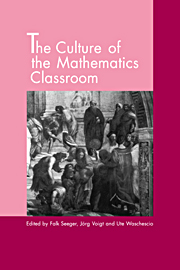Book contents
- Frontmatter
- Contents
- List of contributors
- Acknowledgments
- Introduction
- Part I Changing classroom culture
- Part II Classroom processes
- Part III Epistemology and classroom culture
- 9 The culture of the mathematics classroom and the relations between personal and public knowledge: An epistemological perspective
- 10 Problems of transfer of classroom mathematical knowledge to practical situations
- 11 Cultural perspectives on mathematics and mathematics teaching and learning
- 12 Representations in the mathematics classroom: Reflections and constructions
- 13 Mathematical understanding in classroom interaction: The interrelation of social and epistemological constraints
- Part IV Outlook
- Author index
- Subject index
12 - Representations in the mathematics classroom: Reflections and constructions
Published online by Cambridge University Press: 03 May 2010
- Frontmatter
- Contents
- List of contributors
- Acknowledgments
- Introduction
- Part I Changing classroom culture
- Part II Classroom processes
- Part III Epistemology and classroom culture
- 9 The culture of the mathematics classroom and the relations between personal and public knowledge: An epistemological perspective
- 10 Problems of transfer of classroom mathematical knowledge to practical situations
- 11 Cultural perspectives on mathematics and mathematics teaching and learning
- 12 Representations in the mathematics classroom: Reflections and constructions
- 13 Mathematical understanding in classroom interaction: The interrelation of social and epistemological constraints
- Part IV Outlook
- Author index
- Subject index
Summary
The present chapter uses the concept of representation in a twofold sense: As an external, primarily pictorial, graphic, diagrammatic, or notational form; and as an internal representation, as cognition. In brief, I am discussing the (external) representation of (internal) representation, and vice versa. To indicate what kind of representations I am talking about, I shall use “representations” when I am addressing the external, notational form of representation and “representation” when talking about the internal, cognitive one. Since the advent of cognitive science, the discussion on the nature of internal representation has attracted broad attention from philosophers and psychologists (see, e.g., Dennett 1978; Fodor 1975, 1981; Millikan 1993; Putnam 1988). In this chapter I shall not try to contribute to that discussion; my analysis of representations is, however, indirectly related to one of the main points of this discussion, which has been the critique of a “picture” theory of mental representation. This theory typically assumes that a representation is like what it represents. The critique of this assumption has been picked up by constructivists in the field of mathematics education and turned into a general argument against the “representational view of mind,” saying that we cannot know whether there exists something to be represented, and that representation is only construction. Now, this perspective seems only to apply as long as one sees “representation” as some basically passive reflection of the outside world. In this chapter, the line of argument will be that representation is active construction and that construction without representation is empty.
- Type
- Chapter
- Information
- The Culture of the Mathematics Classroom , pp. 308 - 343Publisher: Cambridge University PressPrint publication year: 1998
- 13
- Cited by



